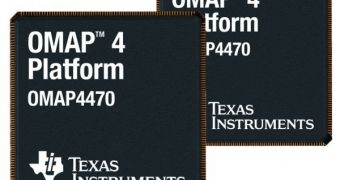ARM chips have been aiming to reach higher performance levels and it looks like Texas Instruments made that wish come true somewhat by designing the OMAP4470 application processor.
Since smartphones and tablets are so quickly evolving, application processors also seem to be cropping up.
So far, the Qualcomm Snapdragon and the NVIDIA Tegra 2 SoC are the main two ARM platforms used in slates.
Still, Texas Instruments has the OMAP4 series of application chips, a series which has now grown by one.
More specifically, TI has delivered the OMAP4470, based on the 45nm manufacturing process and made up of two Cortex-A9 cores, each clocked at 1.8 GHz.
It can handle resolutions of up to 2048 x 1536 pixels (QXGA), is pin-compatible with its predecessors (OMAP4430 and OMAP4460) and should start sampling by the second half of 2011.
"Graphics processing is now at the very heart of the mobile computing experience, providing the gateway to an enriched experience of user interface, gaming, location services, web and media," said Hossein Yassaie, CEO, Imagination Technologies.
"Combining the OMAP 4 platform's low-power, high-performance architecture with the extensive acceleration capabilities and API support of Imagination's POWERVR SGX544 will enable experiences that will really make people sit up and take notice."
For those that want references, web browsing performance should increase by 80% over the OMAP4430, while graphics capabilities are 2.5 times superior.
"Superior mobile computing relies on a user experience that dwarfs all others. Fast and crisp Web browsing, HD and liquid UIs, support for the latest applications-these are the elements consumers judge and buy their devices on,” said Remi El-Ouazzane, vice president, OMAP platform business unit, TI.
“The OMAP4470 processor delivers the maximum experience possible with an unmatched, power-efficient architecture."

 14 DAY TRIAL //
14 DAY TRIAL //